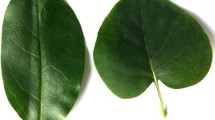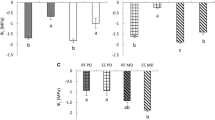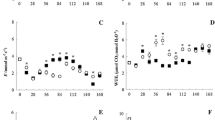Abstract
Leaf light responses, especially structural aspects, are well studied in adult tropical tree species. However, there is still a gap in the knowledge of these plastic responses on first developed leaves, which may be important to seedling survival in variable environments. An experimental approach was used to test the hypothesis that phenotypic plasticity is expressed in first leaves in response to different light intensities. This study was conducted in the Upper Paraná River floodplain, near Porto Rico city (22°55′S, 53°10′W), Southeast Brazil. We quantified the responses of 40 morphological and anatomical traits in first leaves of Eugenia hiemalis Cambess. (Myrtaceae), a riparian shrub that occurs in deep shade and full sun exposure. Seedlings were grown under four treatments: 100, 50, 30, and 0.3 % of full sunlight. Lamina and petiole size was larger in leaves exposed to 0.3 % of full sunlight than in full sun leaves, which have greater leaf thickness, palisade parenchyma, stomatal density, xylem area, and vascular density. Intermediate values were found in 50 and 30 % of full sunlight. The morphological and anatomical variability of E. hiemalis first leaves results from plasticity onset and is regarded as an advantage to seedlings exposed to different light conditions.





Similar content being viewed by others
References
Abrams MD, Kloeppel BD, Kubiske ME (1992) Ecophysiological and morphological responses to shade and drought in two contrasting ecotypes of Prunus serotina. Tree Physiol 10:343–355
Agrawal AA (2001) Phenotypic plasticity in the interactions and evolution of species. Science 294:321–326
Arnim VA, Deng X (1996) Light control of seedling development. Annu Rev Plant Biol 47:215–243
Ashton PMS, Berlyn GP (1994) A comparison of leaf physiology and anatomy of Quercus (section Erythrobalanus—Fagaceae) species in different light environments. Am J Bot 81:589–597
Aubin-Horth N, Renn SCP (2009) Genomic reaction norms: using integrative biology to understand molecular mechanisms of phenotypic plasticity. Mol Ecol 18:3763–3780
Augspurger CK (1984) Seedling survival of tropical tree species: interactions of dispersal distance, light-gaps, and pathogens. Ecology 65:1705–1712
Bazzaz FA (1996) Plants in changing environments: linking physiological, population, and community ecology. University Press, Cambridge
Björkman O (1981) Response to different quantum flux densities. In: Lange OL, Nobel PS, Osmond CB, Ziegler H (eds) Physiological plant ecology I. Response to the physical environment. Encyclopedia of plant physiology. Springer-Verlag, Berlin, pp 57–107
Bögelein R, Hassdenteufel M, Thomas FM, Werner W (2012) Comparison of leaf gas exchange and stable isotope signature of water-soluble compounds along canopy gradients of co-occurring Douglas-fir and European beech. Plant Cell Environ 35:1245–1257
Brodersen CR, Vogelmann TC (2007) Do epidermal lens cells facilitate the absorptance of diffuse light? Am J Bot 94:1061–1066
Brown JR, Archer S (1990) Water relations of a perennial grass and seedling vs adult woody plants in a subtropical savanna, Texas. Oikos 57:366–374
Buckley TN, Warren CR (2013) The role of mesophyll conductance in the economics of nitrogen and water use in photosynthesis. Photosynth Res 119:77–88
Budke JC, Jarenkow JA, de Oliveira-Filho AT (2007) Relationships between tree component structure, topography and soils of a riverside forest, Rio Botucaraí, Southern Brazil. Plant Ecol 189:187–200
Campos JB, Costa-Filho LV (1994) Proposta técnica de implantação da área de proteção ambiental do Arquipélago de Ilha Grande. SEMA/IAP, Curitiba
Campos JB, de Souza MC (1997) Vegetação. In: Vazzoler AEAM, Agostinho AA, Hahn NS (eds) A planície de inundação do alto rio Paraná: aspectos físicos, biológicos e socioeconômicos. EDUEM, Nupélia, Maringá, pp 331–342
Chen FS, Zeng DH, Fahey TJ, Yao CY, Yu ZY (2010) Response of leaf anatomy of Chenopodium acuminatum to soil resource availability in a semi-arid grassland. Plant Ecol 209:375–382
De Kroon H, Hutchings MJ (1995) Morphological plasticity in clonal plants: the foraging concept reconsidered. J Ecol 83:143–152
de Souza MC, Cislinski J, Romagnolo MB (1997a) Levantamento florístico. In: Vazzoler AEAM, Agostinho AA, Hahn NS (eds) A planície de inundação do alto rio Paraná: aspectos físicos, biológicos e socioeconômicos. EDUEM, Nupélia, Maringá, pp 343–368
de Souza MC, Cislinski J, Romagnolo MB (1997b) Levantamento florístico. In: Vazzoler AEAM, Agostinho AA, Hahn NS (eds) A planície de inundação do alto rio Paraná: aspectos físicos, biológicos e socioeconômicos. EDUEM, Nupélia, Maringá, pp 343–368
DeLucia EH, Nelson K, Vogelmann TC, Smith WK (1996) Contribution of intercellular reflectance to photosynthesis in shade leaves. Plant Cell Environ 19:159–170
Dickson WC (2000) Integrative plant anatomy. Academic press, San Diego
Dilcher DL (1974) Approaches to the identification of angiosperm leaf remains. Bot Rev 40:1–157
Evans JR, von Caemmerer S, Setchell BA, Hudson GS (1994) The relationship between CO2 transfer conductance and leaf anatomy in transgenic tobacco with a reduced content of Rubisco. Aust J Plant Physiol 21:475–495
Farnsworth EJ, Ellison AM (1996) Sun-shade adaptability of the red mangrove, Rhizophora mangle (Rhizophoraceae): changes through ontogeny at several levels of biological organization. Am J Bot 83:1131–1143
Fenner M, Thompson K (2005) The ecology of seeds. University Press, Cambridge
Fenner M, Hanley ME, Lawrence R (1999) Comparison of seedling and adult palatability in annual and perennial plants. Funct Ecol 3:546–551
Fischer M, Van Kleunen M (2002) On the evolution of clonal plant life histories. Evol Ecol 15:565–582
Flexas J, Scoffoni C, Gago J, Sack L (2013) Leaf mesophyll conductance and leaf hydraulic conductance: an introduction to their measurement and coordination. J Exp Bot 64:3965–3981
Foster AS (1950) Techniques for the study of venation patterns in the leaves of angiosperms. In: Proceedings of the 7th International Botanical Congress, Stockholm, pp 586–587
Franklin GL (1945) Preparation of thin sections of synthetic resins and wood-resin composites and a new macerating method for wood. Nature 155:51
Gates DM (1980) Biophysical ecology. Springer, New York
Gianoli E, Valladares F (2012) Studing phenotypic plasticity: the advantages of a broad approach. Biol J Linn Soc 105:1–7
Gordon DC, Percy KE, Riding RT (1998) Effects of uv-B radiation on epicuticular wax production and chemical composition of four Picea species. New Phytol 138:441–449
Gratani L (2014) Plant phenotypic plasticity in response to environmental factors. Adv Bot 2014:1–17
Gutschick VP (1999) Biotic and abiotic consequences of differences in leaf structure. New Phytol 143:3–18
Hassiotou F, Ludwig M, Renton M, Veneklaas EJ, Evans JR (2009) Influence of leaf dry mass per area, CO2, and irradiance on mesophyll conductance in sclerophylls. J Exp Bot 60:2303–2314
Hickey LJ (1979) A revised classification of the architecture of dicotyledonous leaves. In: Metcalfe CL, Chalk R (eds) Anatomy of the dicotyledons—systematic anatomy of leaf and stem, with a brief history of the subject, 2nd. Clarendon Press, Oxford, pp 25–39
James SA, Bell DT (2000) Influence of light availability on leaf structure and growth of two Eucalyptus globulus ssp. globulus provenances. Tree Physiol 20:1007–1018
Karban R (2008) Plant behaviour and communication. Ecol Lett 11:727–739
Klich MG (2000) Leaf variations in Elaeagnus angustifolia related to environmental heterogeneity. Environ Exp Bot 44:171–183
Kraus JE, Arduin M (1997) Manual básico de métodos em morfologia vegetal. Editora Universidade Rural, Rio de Janeiro
Lee DW, Oberbauer SF, Krishnapilay B, Mansor M, Mohamad H, Yap SK (1997) Effects of irradiance and spectral quality on seedling development of two Southeast Asian Hopea species. Oecologia 110:1–9
Lenoir J, Gégout JC, Pierrat JC, Bontemps JD, Dhôte JF (2009) Differences between tree species seedling and adult altitudinal distribution in mountain forests during the recent warm period (1986–2006). Ecography 32:765–777
Lusk CH, Reich PB, Montgomery RA, Ackerly DD, Cavender-Bares J (2008) Why are evergreen leaves so contrary about shade? Trends Ecol Evol 23:299–303
Matamala R, Schlesinger WH (2000) Effects of elevated atmospheric CO2 on fine root production and activity in an intact temperate forest ecosystem. Global Change Biol 6:967–979
Nascimento KC, Pastorini LH, Romagnolo MB, Souza LA, Boeger MRT (2013) Unpublished data
Niinemets Ü (1999) Components of leaf dry mass per area–thickness and density–alter leaf photosynthetic capacity in reverse directions in woody plants. New Phytol 144:35–47
Niinemets Ü, Valladares F (2004) Photosynthetic acclimation to simultaneous and interacting environmental stresses along natural light gradients: optimality and constraints. Plant Biol 6:254–268
O’Brien TP, Feder N, Mccully MEO (1964) Polychromatic staining of plant cell walls by toluidine blue. Protoplasma 59:368–373
Oguchi R, Hikosaka K, Hirose T (2003) Does the photosynthetic light-acclimation need change in leaf anatomy? Plant Cell Environ 26:505–512
Paiva ÉAS, Isaias RMDS, Vale FHA, Queiroz CGDS (2003) The influence of light intensity on anatomical structure and pigment contents of Tradescantia pallida (Rose) Hunt. cv. purpurea Boom (Commelinaceae) leaves. Braz Arch Biol Technol 46:617–624
Paraná (1987) Secretaria de Estado da Agricultura e do Abastecimento. Atlas do Estado do Paraná. Instituto de Terras, Cartografia e Florestas, Curitiba
Piel C, Frak E, Le Roux X, Genty B (2002) Effect of local irradiance on CO2 transfer conductance of mesophyll in walnut. J Exp Bot 53:2423–2430
Pitty A (1988) Effect of environmental conditions on velvetleaf and giant foxtail epicuticular wax quantity and quality and the relationship to herbicide penetration. Dissertation, Iowa State University
Price CA, Weitz JS (2010) Zero-sum allocational strategies determine the allometry of specific leaf area. Am J Bot 97:1808–1815
Richardson AD, Berlyn GP, Ashton PM, Thadani R, Cameron IR (2000) Foliar plasticity of hybrid spruce in relation to crown position and stand age. Can J Bot 78:305–317
Richardson AD, Ashton PMS, Berlyn GP, McGroddy ME, Cameron IR (2001) Within-crown foliar plasticity of western hemlock, Tsuga heterophylla, in relation to stand age. Ann Bot 88:1007–1015
Rizzini CT (1977) Sistematização terminológica da folha. Rodriguésia 29:103–125
Romagnolo MB, Souza MC (2006) O gênero Eugenia L. (Myrtaceae) na planície de alagável do Alto Rio Paraná, Estados de Mato Grosso do Sul e Paraná, Brasil. Act Bot Bras 20:529–548
Schmitt J, Wulff RD (1993) Light spectral quality, phytochrome and plant competition. Trends Ecol Evol 8:47–51
Smith H (2000) Phytochromes and light signal perception by plants—an emerging synthesis. Nature 407:585–591
Smith H, Whitelam GC (1997) The shade avoidance syndrome: multiple responses mediated by multiple phytochromes. Plant Cell Environ 20:840–844
Smith WK, Vogelmann TC, DeLucia EH, Bell DT, Shepherd KA (1997) Leaf form and photosynthesis. Bioscience 47:785–793
Souza Filho EE, Stevaux JC (1997) Geologia e geomorfologia do complexo rio Baía, Curutuba, Ivinheima. In: Vazzoler AEAM, Agostinho AA, Hahn NS (eds) A planície de inundação do alto rio Paraná: aspectos físicos, biológicos e socioeconômicos. EDUEM, Nupélia, Maringá, pp 3–46
Sperry JS, Nichols KL, Sullivan JE, Eastlack SE (1994) Xylem embolism in ring-porous, diffuse-porous, and coniferous trees of northern Utah and interior Alaska. Ecology 75:1736–1752
Sultan SE (2004) Promising directions in plant phenotypic plasticity. Perspect Plant Ecol Evol Syst 6:227–233
Terashima I, Hanba YT, Tholen D, Niinemets U (2011) Leaf functional anatomy in relation to photosynthesis. Plant Physiol 155:108–116
Valladares F (1999) Architecture, ecology and evolution of plant crowns. In: Pugnaire FI, Valladares F (eds) Handbook of functional plant ecology. Dekker, New York, pp 121–194
Valladares F, Chico J, Aranda I (2002) The greater seedling high-light tolerance of Quercus robur over Fagus sylvatica is linked to a greater physiological plasticity. Trees 16:395–403
Valladares F, Sanchez-Gomez D, Zavala MA (2006) Quantitative estimation of phenotypic plasticity: bridging the gap between the evolutionary concept and its ecological applications. J Ecol 94:1103–1116
Vogelmann TC (1989) Penetration of light into plants. Photochem Photobiol 50:895–902
Vogelmann TC, Martin G (1993) The functional significance of palisade tissue: penetration of directional versus diffuse light. Plant Cell Environ 16:65–72
Vogelmann TC, Bornman JF, Yates DJ (1996) Focusing of light by leaf epidermal cells. Physiol Plant 98:43–56
Warren CR, Low M, Matyssek R, Tausz M (2007) Internal conductance to CO2 transfer of adult Fagus sylvatica: variation between sun and shade leaves and due to free-air ozone fumigation. Environ Exp Bot 59:130–138
Witkowski ETF, Lamont BB (1991) Leaf specific mass confounds leaf density and thickness. Oecologia 88:486–493
Acknowledgments
We thank CAPES (Coordenação de Aperfeiçoamento de Pessoal de Nível Superior, Brazil) and CNPq (Conselho Nacional de Desenvolvimento Científico e Tecnológico, Brazil) for their support to the accomplishment of this study.
Author information
Authors and Affiliations
Corresponding author
Additional information
Communicated by Erik P Hamerlynck, Ph.D.
Rights and permissions
About this article
Cite this article
Nascimento, K.C., Pastorini, L.H., Romagnolo, M.B. et al. Do Eugenia hiemalis seedling leaves under different light conditions develop phenotypic plasticity?. Plant Ecol 216, 1571–1581 (2015). https://doi.org/10.1007/s11258-015-0540-2
Received:
Accepted:
Published:
Issue Date:
DOI: https://doi.org/10.1007/s11258-015-0540-2




